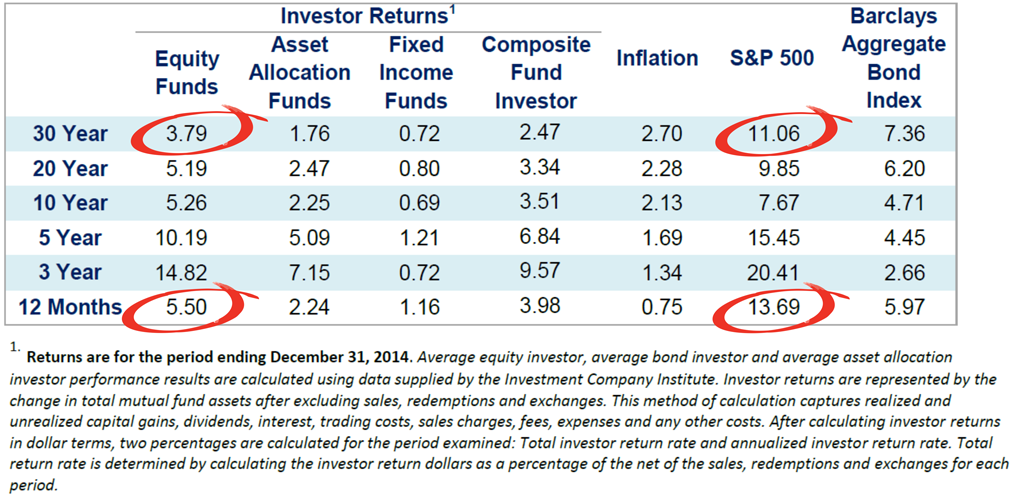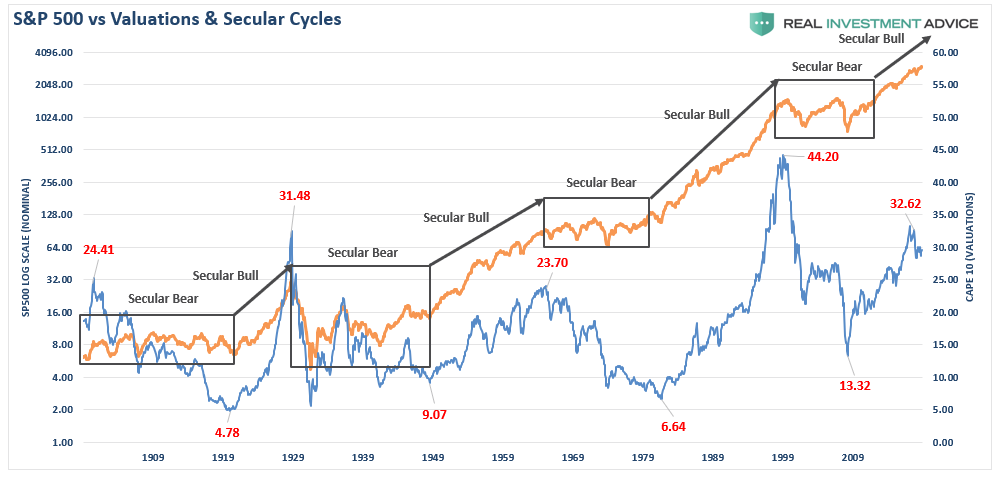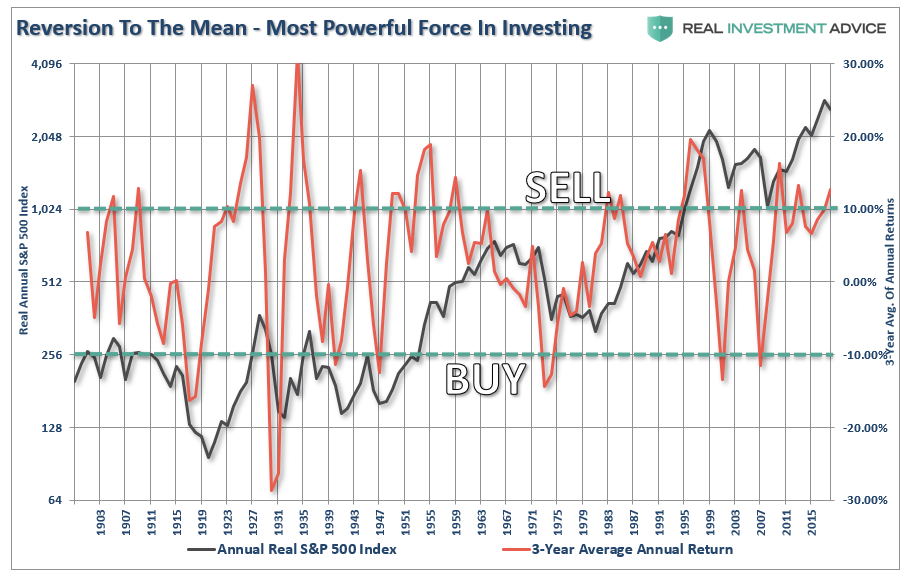Authored by Lance Roberts via RealInvestmentAdvice.com,
Are you an “investor” or a “speculator?”

In today’s market the majority of investors are simply chasing performance. However, why would you NOT expect this to be the case when financial advisers, the mainstream media, and WallStreet continually press the idea that investors “must beat” some random benchmark index from one year to the next.
But, is this “speculation” or “investing?”
Think about it this way.
If you were playing a hand of poker, and were dealt a “pair of deuces,” would you push all your chips to the center of the table?
Of course, not.
The reason is you intuitively understand the other factors “at play.” Even a cursory understanding of the game of poker suggests other players at the table are probably holding better hands which will lead to a rapid reduction of your wealth.
Investing, ultimately, is about managing the risks which will substantially reduce your ability to “stay in the game long enough” to “win.”
Robert Hagstrom, CFA penned a piece discussing the differences between investing and speculation:
“Philip Carret, who wrote The Art of Speculation (1930), believed “motive” was the test for determining the difference between investment and speculation. Carret connected the investor to the economics of the business and the speculator to price. ‘Speculation,’ wrote Carret, ‘may be defined as the purchase or sale of securities or commodities in expectation of profiting by fluctuations in their prices.’”
Chasing markets is the purest form of speculation. It is simply a bet on prices going higher rather than determining if the price being paid for those assets are selling at a discount to fair value.
Benjamin Graham, along with David Dodd, attempted a precise definition of investing and speculation in their seminal work Security Analysis (1934).
“An investment operation is one which, upon thorough analysis, promises safety of principal and a satisfactory return. Operations not meeting these requirements are speculative.”
There is also very important passage in Graham’s The Intelligent Investor:
“The distinction between investment and speculation in common stocks has always been a useful one and its disappearance is a cause for concern. We have often said that Wall Street as an institution would be well advised to reinstate this distinction and to emphasize it in all its dealings with the public. Otherwise the stock exchanges may some day be blamed for heavy speculative losses, which those who suffered them had not been properly warned against.”
Indeed, the meaning of investment has been lost on most individuals. However, the following 10-guidelines from legendary investors of our time will hopefully get you back on track.
10-Investing Guidelines From Legendary Investors
1) Jeffrey Gundlach, DoubleLine
“The trick is to take risks and be paid for taking those risks, but to take a diversified basket of risks in a portfolio.”
This is a common theme that you will see throughout this post. Great investors focus on “risk management” because “risk” is not a function of how much money you will make, but how much you will lose when you are wrong. In investing, or gambling, you can only play as long as you have capital. If you lose too much capital but taking on excessive risk, you can no longer play the game.
Be greedy when others are fearful and fearful when others are greedy. One of the best times to invest is when uncertainty is the greatest and fear is the highest.
2) Ray Dalio, Bridgewater Associates
“The biggest mistake investors make is to believe that what happened in the recent past is likely to persist. They assume that something that was a good investment in the recent past is still a good investment. Typically, high past returns simply imply that an asset has become more expensive and is a poorer, not better, investment.”
Nothing good, or bad, goes on forever. The mistake that investors repeatedly make is thinking “this time is different.” The reality is that despite Central Bank interventions, or other artificial inputs, business and economic cycles cannot be repealed. Ultimately, what goes up, must and will come down.
Wall Street wants you to be fully invested “all the time” because that is how they generate fees. However, as an investor, it is crucially important to remember that “price is what you pay and value is what you get.” Eventually, great companies will trade at an attractive price. Until then, wait.
3) Seth Klarman, Baupost
“Most investors are primarily oriented toward return, how much they can make and pay little attention to risk, how much they can lose.”
Investor behavior, driven by cognitive biases, is the biggest risk in investing. “Greed and fear” dominate the investment cycle of investors which leads ultimately to “buying high and selling low.”
4) Jeremy Grantham, GMO
“You don’t get rewarded for taking risk; you get rewarded for buying cheap assets. And if the assets you bought got pushed up in price simply because they were risky, then you are not going to be rewarded for taking a risk; you are going to be punished for it.”
Successful investors avoid “risk” at all costs, even it means under performing in the short-term. The reason is that while the media and Wall Street have you focused on chasing market returns in the short-term, ultimately the excess “risk” built into your portfolio will lead to extremely poor long-term returns. Like Wyle E. Coyote, chasing financial markets higher will eventually lead you over the edge of the cliff.
5) Jesse Livermore, Speculator
“The speculator’s deadly enemies are: ignorance, greed, fear and hope. All the statute books in the world and all the rule books on all the Exchanges of the earth cannot eliminate these from the human animal….”
Allowing emotions to rule your investment strategy is, and always has been, a recipe for disaster. All great investors follow a strict diet of discipline, strategy, and risk management. The emotional mistakes show up in the returns of individuals portfolios over every time period. (Source: Dalbar)

6) Howard Marks, Oaktree Capital Management
“Rule No. 1: Most things will prove to be cyclical.
Rule No. 2: Some of the greatest opportunities for gain and loss come when other people forget Rule No. 1.”
As with Ray Dalio, the realization that nothing lasts forever is critically important to long term investing. In order to “buy low,” one must have first “sold high.” Understanding that all things are cyclical suggests that after long price increases, investments become more prone to declines than further advances.

7) James Montier, GMO
“There is a simple, although not easy alternative [to forecasting]… Buy when an asset is cheap, and sell when an asset gets expensive…. Valuation is the primary determinant of long-term returns, and the closest thing we have to a law of gravity in finance.”
“Cheap” is when an asset is selling for less than its intrinsic value. “Cheap” is not a low price per share. Most of the time when a stock has a very low price, it is priced there for a reason. However, a very high priced stock CAN be cheap. Price per share is only part of the valuation determination, not the measure of value itself.
8) George Soros, Soros Capital Management
“It’s not whether you’re right or wrong that’s important, but how much money you make when you’re right and how much you lose when you’re wrong.”
Back to risk management, being right and making money is great when markets are rising. However, rising markets tend to mask investment risk that is quickly revealed during market declines. If you fail to manage the risk in your portfolio, and give up all of your previous gains and then some, then you lose the investment game.
9) Jason Zweig, Wall Street Journal
“Regression to the mean is the most powerful law in financial physics: Periods of above-average performance are inevitably followed by below-average returns, and bad times inevitably set the stage for surprisingly good performance.”
The chart below is the 3-year average of annual inflation-adjusted returns of the S&P 500 going back to 1900. The power of regression is clearly seen. Historically, when returns have exceeded 10% it was not long before returns fell to 10% below the long-term mean which devastated much of investor’s capital.

10) Howard Marks, Oaktree Capital Management
“The biggest investing errors come not from factors that are informational or analytical, but from those that are psychological.”
The biggest driver of long-term investment returns is the minimization of psychological investment mistakes.
As Baron Rothschild once stated: “Buy when there is blood in the streets.” This simply means that when investors are “panic selling,” you want to be the one they are selling to at deeply discounted prices. Howard Marks opined much of the same sentiment: “The absolute best buying opportunities come when asset holders are forced to sell.”
As an investor, it is simply your job to step away from your “emotions” for a moment and look objectively at the market around you. Is it currently dominated by “greed” or “fear?” Your long-term returns will depend greatly not only on how you answer that question, but to manage the inherent risk.
“The investor’s chief problem – and even his worst enemy – is likely to be himself.” – Benjamin Graham
As I stated at the beginning of this missive, “Market Timing” is not an effective method of managing your money. However, as you will note, every great investor through out history has had one core philosophy in common; the management of the inherent risk of investing to conserve and preserve investment capital.
“If you run out of chips, you are out of the game.”
